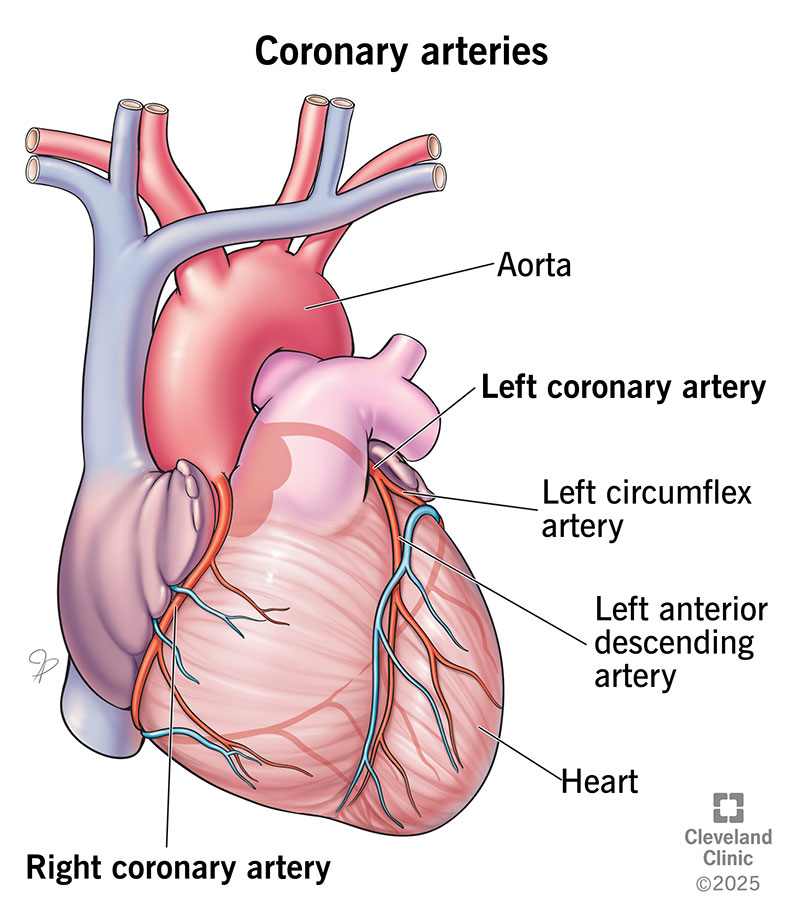Your right and left coronary arteries supply blood to your heart. They’re the first branches off your aorta, which is the main artery in your body. Your coronary arteries and their branches supply all parts of your heart muscle with blood.
Advertisement
Cleveland Clinic is a non-profit academic medical center. Advertising on our site helps support our mission. We do not endorse non-Cleveland Clinic products or services. Policy

Your coronary arteries are major blood vessels that supply blood to your heart. They make it possible for your heart to beat and pump blood throughout your body. Your coronary arteries branch off your aorta — the main artery in your body. But their arrangement can vary significantly from person to person.
Advertisement
Cleveland Clinic is a non-profit academic medical center. Advertising on our site helps support our mission. We do not endorse non-Cleveland Clinic products or services. Policy
You may learn about your coronary arteries after having a heart attack or a heart procedure, like an angioplasty. A blockage in one or more of your coronary arteries is what typically causes a heart attack.
The main function of your coronary arteries is to supply your heart with blood. Your heart is a muscle that needs a constant flow of oxygen-rich blood to work properly. Coronary arteries and their smaller vessels supply this blood.
You have a right coronary artery (RCA) and a left main coronary artery (LMCA). Each has smaller branches that go deep inside your heart muscle. These two main coronary arteries have specific roles.
Your right coronary artery (RCA) supplies blood to your right atrium and ventricle. This is where oxygen-poor blood goes before heading to your lungs.
The RCA’s branches typically supply the sinoatrial (SA) and atrioventricular (AV) nodes. These nodes send electrical signals through your heart. This allows your heart muscles to know when to contract. Branches of the RCA also give blood to one-third of your interventricular septum. This is the wall between your heart’s two lower chambers.
Your left main coronary artery (LMCA) supplies blood to your left atrium and ventricle. This is where oxygen-rich blood arrives from your lungs before your heart pumps it out to the rest of your body. Your LMCA’s branches supply blood to the other two-thirds of your interventricular septum.
Advertisement
Your coronary arteries are around and inside your heart muscle (myocardium). They branch off your aorta and receive blood directly from it.
They start at the aortic root, which is the first part of your aorta that comes from the left ventricle of your heart. The left ventricle is where oxygen-rich blood leaves your heart and starts its journey through your body. The coronary artery branches are the first of many branches off your aorta.
The layout of coronary arteries can vary widely from person to person. Some examples of these differences (variants) include:
There are other anomalies of the coronary arteries that you can be born with that might require treatment.
Most of these differences aren’t harmful and don’t cause symptoms. But in rare cases (less than 1% of people), coronary artery abnormalities can lead to serious problems or even death.
The main coronary arteries are usually between 3 and 4 millimeters in diameter. That’s a little smaller than the width of a drinking straw. The sizes of the arteries vary slightly according to your sex, body weight and ethnicity.
Coronary artery disease (CAD) is the most common condition that affects your coronary arteries. CAD is often the result of atherosclerosis. This is plaque buildup inside your arteries. Clogged arteries prevent blood from getting to your heart, which can lead to a heart attack. CAD is also the most common form of heart disease in the U.S.
Another condition is acute coronary syndrome. It’s a broad term for three types of CAD that result in a sudden loss of blood flow to your heart through your coronary arteries.
Less common conditions that affect your coronary arteries include:
Chest pain (angina) is the most common symptom of coronary artery issues. Be sure to see your healthcare provider if you have chest pain.
For many people, a heart attack is the way they find out they have coronary artery disease. Call 911 (or your local emergency service number) right away if you have any of these symptoms, which could be signs of a heart attack:
Advertisement
Keep your heart and coronary arteries healthy by:
Your coronary arteries have a very important job — to supply your heart muscle with blood so it can function. So, try to do all you can to keep them healthy. Talk to your healthcare provider about how to manage your coronary artery disease risks. They’re available to help you.
Advertisement
When you need treatment for coronary artery disease, you want expert care. At Cleveland Clinic, we’ll create a treatment plan that’s personalized to you.

Last reviewed on 06/02/2025.
Learn more about the Health Library and our editorial process.